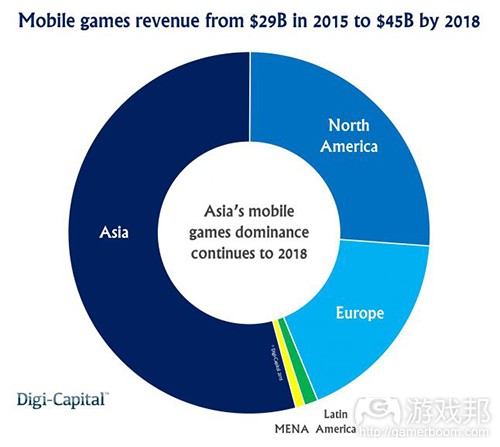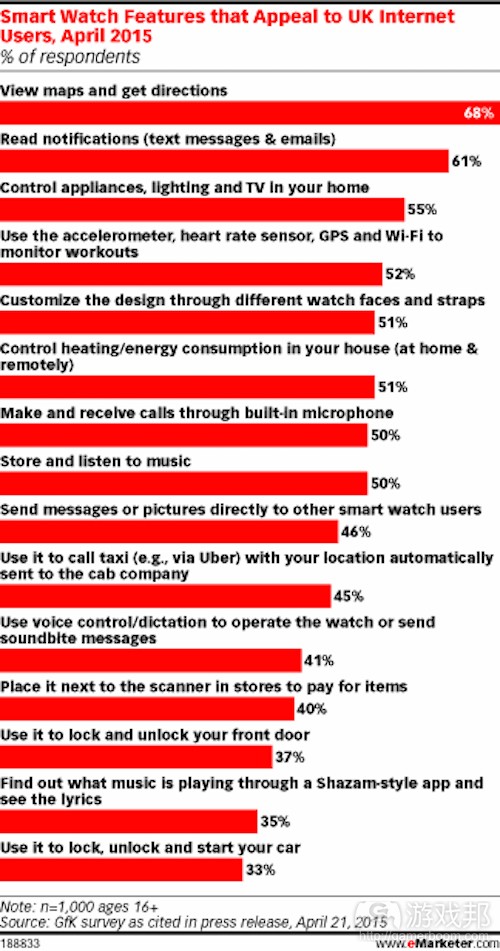每日观察:关注Digi-Capital预测游戏市场状况(5.5)
1)Digi-Capital最新报告预测,2015年全球游戏软件收益将达880亿美元,到2018年将增长至1100亿美元,年增幅达8%。
2015年手机游戏收益将超过网络游戏,以及主机软件业务。今年玩家在游戏中每投入的10美元中,就有3美元属于手机游戏,预计到2018年这一数据将增长至4美元。
今年手机游戏收益将达290亿美元,2018年将增长至450亿美元,年增幅为15%。自2013年以来亚洲一直主导手机游戏市场,预计2018年这一地区在手机游戏收益中占比将超过50%。但手机游戏畅销榜单排名趋于稳定的局势仍然不会改变,对中小开发者及独立开发商将构成更为严峻的挑战。
中国众多Android应用商店的下载量已经远超苹果iOS和Google Play平台;预计到2018年Android游戏收益将超过iOS平台,但目前来看,App Store每次下载量所得收益仍然高于其他手机应用商店,Google Play要实现2次下载,中国Android应用商店需实现8次下载,才可能创造相当于iOS一次下载的所得收益。
2)据Polygon报道,主机游戏开发商Spark Unlimited日前关闭工作室及2004年发布的《使命召唤:决胜时刻》,并遣散了所有员工。
该公司成立于2002年,并于2004年发布其首款游戏《使命召唤:决胜时刻》。
3)据gamesbeat报道,手机社交游戏发行商SGN(代表作《Cookie Jam 》)日前聘请Melissa Bachman-Wood出任公司旧金山工作室总经理,将负责监管该工作室的编程、美示意图设计等各个开发环节。
女性工作室主管在游戏行业中仍然较为罕见,Melissa Bachman-Wood已经拥有丰富的游戏制作经验,进入游戏行业中已将近20年,曾在EA参与开发《模拟人生》系列。
她在EA就职时间超过10年,之后加入Foundation 9和Backbone Entertainment,在上一家就职公司Kixeye中负责监管《Battle Pirates》和《War Commander》等社交游戏项目开发。
4)推送信息服务公司Urban Airship最近调查报告显示,用户进入应用推送通知的平均率已经从2013年的45%降至2015年的42%,而其调查的样本基数却比当时大3倍(游戏邦注:其调查范围仅限iOS应用,所搜集数据来自2946款应用,这些应用至少向5.33亿用户发送了930亿次推送通知)。
与2013年情况相比,零售类应用的推送通知进入率下降最严重,从46%降至36%;媒体类应用则从50%降至42%。慈善类及非盈利性应用的进入率最高(58%),其次是商务类应用(54%)。
游戏类应用推送通知表现最糟糕,平均进入率仅为33%,博彩类应用以及美食美酒应用则是36%,教育、体育、旅行和实用工具应用的平均进入率都在40%左右。
报告认为进入率下降的一个原因可能是推送通知服务已经非常普遍,零售商在2014年加倍向用户推送通知,用户对这些信息的响应率也比2013年高2倍。报告认为越多应用推送通知来争取用户注意力,用户在选择进入信息时就会越挑剔。
该报告还指出,选择进入推送通知的用户对应用的粘性也会比一般用户高4倍,留存率也会比后者高2倍。
5)GfK最近执行的调查结果显示,年龄介于25至34岁的网络用户是最有可能在未来半年购买智能表,该群体中有此意向的用户比例达26%;而年龄介于45至54岁并且有此意向的用户仅为12%,16至24岁群体以及34至44岁群体的这一比例同为16%。
39%受访者表示对苹果智能表感兴趣,57%打算购买这一设备的用户表示会等Apple Watch面世后再做最后决定。
在今年初的另一项关于可穿戴设备的调查中,2000名受访者中有10%用户表示正考虑在今年购买智能表,18%则要等3个月后再做决定。有意向购买智能表的用户看中的是这种设备比智能手机更便捷,26%则希望成为最先持有Apple Watch的用户。
GfK调查显示,用户最期待的智能表功能分别是导航(68%),查看推送通知(61%),以及操控家中的其他智能设备(55%);音乐识别以及解锁和上锁家门/车门则是用户最不重视的智能表功能。(本文由游戏邦编译,转载请注明来源,或咨询微信zhengjintiao)
1)Leaders dominate $45 billion mobile games revenue forecast by 2018
by Tim Merel
The games industry changed in the last decade from a market dominated by console and online publishing giants, to an explosion of new and disruptive mobile insurgents. Now the market has gone back to the future, with a stable group of games leaders in the top grossing charts set to dominate for the next few years (although the AR/VR wild card could produce breakout success). To see where the market is headed, let’s dig into the games industry revenue forecast and mobile games revenue forecast from Digi-Capital’s new Games Digest and Games Report Q1 2015.
Games software revenue forecast from $88 billion in 2015 to $110 billion by 2018
Digi-Capital forecasts that games software revenue will grow from $88 billion in 2015 to $110 billion by 2018 at 8% annual growth (see sector split below and games sector/country revenue forecast data here). In a single digit growth market, games leaders with hit IPs, user scale and cashflow are spending more on marketing (Superbowl ads included) and development to drive shareholder value. This dynamic has eaten into games industry margins, and made it more expensive for newcomers to break through (although indie games like Monument Valley will always capture the imagination).
Mobile games will generate more revenue than online games in 2015, as well as more revenue than console software (although not console hardware and software combined – see games hardware revenue forecasts here). Where mobile games will take $3 of every $10 spent by gamers on software in 2015, that figure will go up to $4 out of every $10 by 2018.
Mobile games revenue forecast from $29 billion in 2015 to $45 billion by 2018
Digi-Capital forecasts that mobile games revenue will grow from $29 billion in 2015 to $45 billion by 2018 at 15% annual growth. Asia has dominated mobile games revenue since 2013, compared to both North America and Europe, and Digi-Capital forecasts Asia to take over 50% of all mobile games revenue in 2018 (see regional split below and regional mobile games revenue forecast data here). Stable top grossing mobile games charts look set to remain the norm. This is great for games leaders and their shareholders, but puts the big squeeze on mid-tier players and makes breaking through more challenging for indies.
Android games revenue will be higher than iOS (including China) by 2018
Accepted wisdom and research tells us that iOS makes more money than Google Play, despite Google Play having more downloads. Nobody would argue with that. But what about iOS vs Android at a global level? Include the massive Chinese Android app stores, and Android didn’t just dominate download volumes, it made more money than iOS last year.
China, where Baidu, Apple, Qihoo 360, Tencent, Wandoujia and others compete for the largest download market in the world, has tipped the balance in Android’s favor. Chinese Android app stores put both iOS (with a rapidly growing Chinese business) and Google Play (with limited Chinese presence) in the minority of app downloads globally. See app store download volume shares (all apps, not just games) in the chart below and download volume shares here.
Dominating downloads is great, but downloads can be a vanity metric if they aren’t backed up by corresponding revenue. So while in 2018 iOS should still have the highest mobile games revenue of any one individual app store globally (followed by Google Play and Chinese Android), mobile games revenue from all Android app stores combined could top iOS. In other words, Android could make more money for games developers than iOS by 2018. And that’s a big deal.
Yet iOS remains the easier app store for monetization per download, as it takes over two downloads on Google Play and over eight downloads on Chinese Android app stores to make the same amount of money as one iOS download. Mobile games revenue splits by app store are below and mobile games revenue forecasts by app store type are here.
With games leaders set to continue their dominance in established games sectors, the amazing innovations coming out of AR and VR could give rise to an entirely new set of disruptive insurgents. Let the games begin!(source:gamasutra)
2)Lost Planet 3 developer Spark Unlimited shuts down
Dean Takahashi
The developer of Lost Planet 3 and one of the first Call of Duty games has shut down.
Polygon reported today that Spark Unlimited, the maker of console games such as Legendary and Yaiba: Ninja Gaiden Z, is no longer making games and that it has laid off all of its employees. Craig Allen, who was the chief executive there until last fall, said in an email, “My understanding is this is accurate” when asked if the story was correct.
The Polygon report cites that a member of the NeoGaf game forum saw that assets were up for sale on asset liquidation site CMA Auctions. John Butrovich, the chief technical officer at Spark Unlimited, confirmed to Polygon that principal members of the studio “have decided to move on to other things.” He said that Spark’s in-development free-to-play game was canceled.
Spark Unlimited was founded in 2002, and released its first game, Call of Duty: Finest Hour, in 2004. That led to an eventual lawsuit with Activision and a parting of ways on Call of Duty, which went on to become a billion dollar-per-year franchise.(source:venturebeat)
3)Cookie Jam maker SGN hires female exec to run its S.F. office
Dean Takahashi
SGN is the social mobile game publisher that brought us Cookie Jam, and it’s hired Melissa Bachman-Wood as the new general manager of the company’s San Francisco office.
Female studio chiefs are still relatively rare in the game industry, but it makes good business sense for a company with so many players who are women. On top of that, Bachman-Wood has deep experience in making games, said Josh Yguado, president and chief operating officer of Los Angeles-based SGN, in an interview with GamesBeat. Bachman-Wood will lead the Bay Area game studio — something that most big game companies eventually create.
“Melissa is a gaming industry expert. Developing one of the world’s most successful franchises — The Sims — she has firsthand knowledge of how to create, scale and globalize social games,” said Chris DeWolfe, the CEO of SGN, in a statement. “With her leadership, our Bay Area studio will continue to thrive.”
Bachman-Wood has nearly two decades of games industry expertise, including nine years with the teams behind the legendary “Sims” franchise for Electronic Arts.
She spent more than a decade at EA. She moved on to roles at Foundation 9 and Backbone Entertainment, and she then assumed her most recent job with Kixeye. There, she oversaw development of social gaming titles such as Battle Pirates and War Commander. Her blend of experience in traditional, PC, and social gaming provides SGN with world-class expertise to continue building top-tier development capabilities, the company said.
“The mobile gaming industry has grown exponentially, and SGN is a leading developer of top titles,” said Bachman-Wood in a statement. “This is a tremendous opportunity to bring my background creating and managing successful games to one of the fastest growing companies in the industry.”
Bachman-Wood will be responsible for all aspects of development for the company’s San Francisco studio including engineering, art and design and will report to SGN Yguado.(source:venturebeat)
4)Average app push notification opt-in rates have dropped by 3% since 2013
Andy Boxall
The amount of people opting in to app push notifications is dropping, according to research conducted by Urban Airship, which specialises in push messaging. Published in its Mobile Engagement Industry Benchmarks report, it’s stated the average opt-in has fallen from 45% in 2013 to 42% in 2015, despite the data sample being three times the size.
Comparing this year’s data with that of 2013, two app categories suffered the largest drop off in opt-in adoption. Retail fell from 46% to 36%, and media from 50% to 42%. The data breaks down the average opt-in figures by app store category. It shows charities and non-profits have the best average result at 58%, followed by business at 54%.
Average push notification opt-in is now 42%
Gaming suffers worst with a mere 33% average push opt-in, with gambling apps along with food and drink apps coming next, both with 36%. Education, sports, travel, and utility apps all hover around the high 40% mark.
A possible reason for this reduction is that push notifications are now commonplace. Retailers doubled the amount of app notifications sent to users at important shopping times during 2014, and these messages where responded to at twice the rate of 2013. The report notes the more apps send out broadcast-style notifications to gain attention, the more picky users will be with which apps are granted permission to send them in the first place.
According to Urban Airship, the 3% fall is, “not cause for alarm,” and the figure has been taken using median figures, and that the high performance apps which follow notification guidelines have a considerably higher than average opt-in rate. Instead, it’s recommended developers and publishers should be concentrating on the 58% who are currently unaddressed by push notifications. Urban Airship makes the importance of push notifications clear. It says users that opt-in are four times as engaged with apps, and have twice the retention rate of those who opt-out.
The report only examines iOS apps, and used data aggregated from 2946 apps that had collectively sent at least 93 billion notifications to more than 533 million users. The full report can be downloaded for free here.(source:businessofapps)
5)People aged between 25 and 34 shown to be most likely to buy a smartwatch in the next 6 months
Andy Boxall
Research conducted by GfK, and collated by eMarketer, shows Internet users between the age of 25 and 34 are the most likely to purchase a smartwatch in the next six months. At 26%, this category was way ahead of all other polled age groups. Only 12% of those aged 45 to 54 were expecting to splash out on a smartwatch soon, while 16% of the 16 and 24, and 34 to 44 age bracket said they were similarly interested.
The 25 to 34 age group is most interested in smartwatches
The Apple Watch proved a popular choice, with 39% of the surveyed individuals saying they were in some way interested in Apple’s first wearable product. In total, 57% of those expecting to buy a smartwatch said they were waiting to see the Apple Watch before making a final decision.
Ben Wood, a researcher for CCS Insight, said:
ben wood
“There is a huge ‘I want one” factor for smartwatches. That’s why we believe the Apple Watch will become the best-selling smart watch in history on its first weekend of sales.”
Wood assisted with a Barclaycard study into wearables at the beginning of the year, which showed 10% of the 2000 people surveyed were considering a smartwatch purchase during the year, while 18% said they would make a decision in the next three months. Prospective smartwatch owners wanted greater convenience than a smartphone from a wearable, and 26% wanted to be among the first to own an Apple Watch.
Maps, notifications, and fitness features are among the most desirable on a smartwatch.
The top three most wanted features on a smartwatch, according to respondents to the GfK study, are to use mapping software and get directions, see and read notifications from a smartphone, and to control other smart devices in the home. Fitness tracking and a heart rate sensor came next, and the ability to customise watch faces and straps came in fifth. The least important features were music recognition, and the ability to lock and unlock home and car doors.(source:businessofapps)
















































 闽公网安备35020302001549号
闽公网安备35020302001549号